In the late nineteenth century, scientists, psychiatrists, and medical
practitioners began employing a new experimental technique for the study
of neuroses: hypnotism. Though the efforts of the famous French
neurologist Jean-Martin Charcot to transform hypnosis into a laboratory
science failed, his Viennese translator and disciple Sigmund Freud took
up the challenge and invented psychoanalysis. Previous scholarship has
viewed hypnosis and psychoanalysis in sharp opposition or claimed that
both were ultimately grounded in the phenomenon of suggestion and thus
equally flawed. In this groundbreaking study, Andreas Mayer reexamines
the relationship between hypnosis and psychoanalysis, revealing that the
emergence of the familiar Freudian psychoanalytic setting cannot be
understood without a detailed analysis of the sites, material and social
practices, and controversies within the checkered scientific and medical
landscape of hypnotism.
Sites of the Unconscious analyzes the major controversies between
competing French schools of hypnotism that emerged at this time,
stressing their different views on the production of viable evidence and
their different ways of deploying hypnosis. Mayer then reconstructs in
detail the reception of French hypnotism in German-speaking countries,
arguing that the distinctive features of Freud's psychoanalytic setting
of the couch emerged out of the clinical laboratories and private
consulting rooms of the practitioners of hypnosis.

